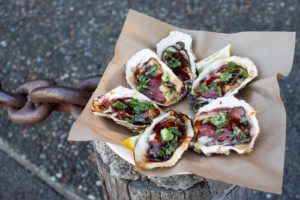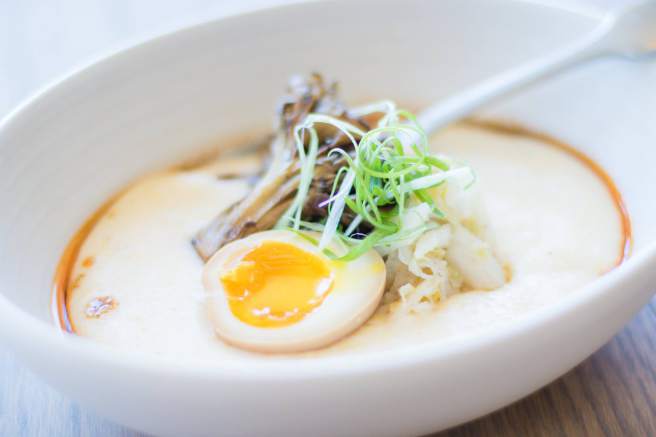In the ever-frenetic world of modern restaurants, a chef is only as good as his last dish. Fickle diners get bored, and food trends move so quickly from fried chicken to kale that, increasingly, chefs are pushing limits to keep a buzz around their kitchen.
It has become such a daily thought in menu planning that these days, even wacky works. Adventure, it seems, stokes appetites.
Few in food-centric Wine Country know that better than David Blomster, owner of Dick Blomster’s Korean Restaurant in Guerneville. Operated as an evening pop-up in the ramshackle circa-1945 Pat’s diner on Main Street, Dick’s has been clobbering the culinary envelope since it debuted in 2012, with hard-to-explain dishes like braised chrysanthemum leaves tossed with hot chiles, maitake mushrooms and black bean sauce, or a humble hot dog chow mein.
“Dino kale and Pop Rocks did not work,” Blomster said, reflecting on an opening month salad of crispy Dinosaur kale and flying lotus root chips sprinkled in Pop Rocks candy. “But surprisingly, cheese, rice and peanut butter works pretty well together.”
Just as surprisingly, perhaps, customers are eating the crazy stuff up. On weekends, his cozy 78-seat café serves up to 700 diners a night, and so Blomster is opening a second location later this month as a pop-up in Don Taylor’s Omelette Express in downtown Santa Rosa. On the menu: a fried PB&J sandwich coated in pancake batter and topped in vanilla ice cream and Pop Rocks, plus a rice bowl with KFC (Korean fried crack) — soy-ginger chicken, egg, seaweed and gochujang fermented chile paste.
It is still the time of quinoa, anything artisanal, fried eggs or gourmet beans on absolutely everything, plus kale-kale-kale everywhere, as it has been for several years.
But now, alongside trendy small plates, open kitchens, communal tables and everything organic, we want Sonoma County seaweed (kombu) in our chicken noodle soups, kimchee in our burgers and milk whey in our cocktails. The more unusual the eats, the better.
It’s not just for fancy restaurants, either. Avant-garde is nothing new for upscale restaurants — the French Laundry’s red chile-spiked coconut milk tapioca atop mango sorbet, anyone? Yet now, the out-there combinations are de rigueur at even the most casual places. At Casino in Bodega, for example, the tiny kitchen behind the dark bar and beer-perfumed pool tables sends out nightly changing dishes that include a lofty mixed roast of Berkshire pork loin, cheek and rib decorated with Spanish roja garlic, roma de tigres and anise hyssop.
Roma de tigres are striped red and orange tomatoes he found at a local farmers’ market, explained Casino chef Mark Malicki. “The Latin American lady called them ‘tiger tomatoes’ in Spanish, and I thought it was cool,” he said.
“I like to put things on the menu people might not recognize, because it helps start a dialogue with their server and creates kind of a bond.”
At Santa Rosa’s new bistro-style Bird & Bottle, which opened at the end of September, chef Mark Stark sends out curious inventions like kimchee latkes and pickled gulf shrimp served with Korean chile buttered southern Saltine crackers. And for brunch service rolling out in a few weeks, he’s playing with a pork belly monkey bread.
“It’s always been my philosophy to pair the unusual with the usual,” said Stark. “There are certainly adventurous diners, but I also feel that a chef can grow a guest’s trust level by delivering consistently good food.”
Chef Dustin Valette is such a proponent of that philosophy that at his new Valette Restaurant, which opened in Healdsburg in March, he has a “Trust Me” section of the menu. Here, diners throw caution to the wind and let him create whatever dishes he fancies, in a minimum of four courses. That has resulted in unique bites such as squid ink-painted puff pastry with steamed scallops in a Champagne beurre blanc, alongside already creative menu listing options like deconstructed Nicoise salad of ahi, olives, cucumber, chive, 64-degree egg and olive oil “snow.”
The snow is extra virgin olive oil mixed with cold refined tapioca starch, for a delicate powder that tastes like oil without the heaviness.
“Dining out isn’t just calorie consumption,” said Valette. “I want to create things people can’t make at home. All chefs are trying to stand out from the crowd, and I do it with new techniques and uncommon ingredients. From bottom restaurants — even Burger King is doing a black bun (tinted with A.1. sauce) for Halloween — to top tier chefs, we don’t have to follow the rules anymore.”
Of the 100-plus diners he serves even on weekday nights at his 49-seat rustic-chic eatery, Valette estimates at least 40 percent order the Trust Me menu, with that number approaching 100 percent on some weekend nights.
Still, such unusual plates as Bird & Bottle’s matzo ball ramen dashi soup or chicken fried oysters with shiso leaf and spicy mayo can be a hard sell, local restaurateurs agree.
“As a chef, I like to expose guests to new flavors and different food items, but sometimes it is a challenge to get them to order those,” said Stark. “I have found it works to pair an unusual item with a familiar preparation, for example, buffalo style sweetbreads. Or I take something like kimchee that might be unfamiliar, and serve it with something more familiar like latkes and sour cream.
“Hopefully the thought process for the guest is, ‘I know I like latkes, maybe I’ll like kimchee as well.’”
Valette tries to draw on nostalgia and a touch of whimsy for some of his more elaborate dishes. A brand new menu item, for example, creates a pavé of crunchy granola base layered with duck confit, cocoa nibs, goji berry, toasted oat and a granola top, all compressed. It’s served with a cocoa nib crusted roast duck breast with pickled goji berry, cashews and endive salad atop a plate painted in hibiscus gastrique.
Calling it a granola bar instead of pavé stirs childhood taste memories and approachability, he explained.
Sometimes, too, chefs realize that, like that kale and Pop Rocks, an idea simply isn’t going to float.
“I really wanted to present some sort of preparation using cockscomb, but I’m not sure if our guests are ready for that,” Stark laughed. “I haven’t gained their trust yet. Maybe in a couple of months, I’ll deep fry some.”
Blomster, meanwhile, believes diners find the joy — and humor — in his recipes as much as they do with his other Guerneville business, Studio Blomster art gallery.
“Everything I do, I approach as art, including my restaurant adventures,” he said. “People are entering a new mannerist period now where we organize, break classic rules and invent new context. I mean, I’m a Midwestern Caucasian man serving Korean food in a historic diner in a wonderful, generous, accepting, rural, west coast, hippie, junkie, yuppie, gay river town.”
For any chef wanting to nail another remarkably strong food trend, there’s even a sustainable factor in using offbeat ingredients, Stark said.
“For me, the desire to present new food items for our guests to enjoy really comes from a place of respect for the raw ingredient, whether that ingredient is an octopus or an artichoke,” he said. “With the rising cost of food and the scarcity and overproduction of certain species, we as cooks need to embrace total utilization and respectfully use the whole animal. I say, if you want to call yourself ‘green,’ sauté some sweetbreads, pickle a tongue, braise some oxtail or grill a fish collar.”
And at the end of the day, even the most fashion-forward chefs recognize the classics are important, too. So Blomster also offers Korean staples like kimchee fried rice topped in a golden yolk sunny-side-up egg, and the beloved Americana Shake ‘N Bake pork chop with braised greens and apple sauce.
Stark sends out Bird & Bottle signatures like fried chicken with Chinese Mumbo hot sauce, or wood grilled whole fish sprinkled in gremolata and vinegar.
“Even as a chef, I still like to just eat, without having to figure out what I am eating,” Stark said. “We try to have a balance of familiar on our menus as well as the opportunity for the guest to try something different.”










